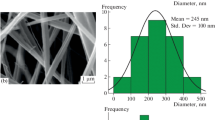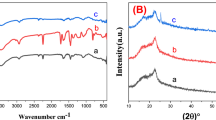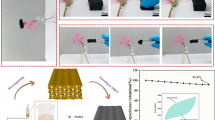Abstract
The flexible polyindole/carbon nanotube/bacterial cellulose (PIn/CNT/BC) nanofiber nonwoven electrode is prepared by a two-step method combination of ‘electrospinning and electrospray’ process and potentiostatic polymerization. The structure and morphology of the as-prepared PIn/CNT/BC nonwoven electrode are investigated by Scanning electron microscopy, Transmission electron microscopy, Fourier transform infrared, Brunauer–Emmett–Teller and Energy dispersive spectroscopy. The PIn/CNT/BC electrode has a hierarchy configuration with a broccoli-like rough surface consisting of BC electrospun nanofibers, CNT coating layer and PIn nanoparticle layer, which play the function of supporting substrate, conductive path and electrode active material, respectively. To evaluate the electrochemical properties of PIn/CNT/BC electrode, cyclic voltammetry, galvanostatic charge/discharge and electrochemical impedance spectroscopy tests are performed. The unique structure ensures that the flexible PIn/CNT/BC nanofiber nonwoven electrode exhibits larger specific capacitance up to 552.6 F g−1, longer operation life with 95.6% capacitance retention after 5000 cycles, better conductivity with a fitting value of charge-transfer resistance of 9.87 Ω, outstanding flexibility and stability with specific capacitance retention over 96.4% after 1500 bending cycles. The remarkable electrochemical performance of PIn/CNT/BC nanofiber nonwoven electrode offer promising applications as flexible energy storage device for wearable and smart electronic components.









Similar content being viewed by others
References
Alekseyev NI, Broyko AP, Kalyonov VE, Korlyakov AV, Lagosh AV, Livshits AO et al (2018) The structure of silver modified flexible graphene electrodes for actuators in biomimetic systems. J Struct Chem 59(4):891–899
Ankhili A, Tao X, Cochrane C, Coulon D, Koncar V (2018) Washable and reliable textile electrodes embedded into underwear fabric for electrocardiography (ecg) monitoring. Materials 11(2):256. https://doi.org/10.3390/ma11020256
Babu RS, Barros ALFD, Maier MDA, Sampaio DDM, Balamurugan J, Lee JH (2018) Novel polyaniline/manganese hexacyanoferrate nanoparticles on carbon fiber as binder-free electrode for flexible supercapacitors. Compos B Eng 143:141–147
Brandes R, Carminatti C, Mikowski A, Al-Qureshi H, Recouvreux D (2017) A mini-review on the progress of spherical bacterial cellulose production. J Nano Res 45:142–154
Cai Z, Zhang R, Shi X (2012) Preparation and characterization of polyindole nanofibers by electrospinning method. Synth Met 162(23):2069–2074
Cai ZJ, Zhang Q, Song XY (2016) Improved electrochemical performance of polyindole/carbon nanotubes composite as electrode material for supercapacitors. Electron Mater Lett 12(6):1–11
Choudhury A, Kim JH, Mahapatra SS, Yang KS, Yang DJ (2017) Nitrogen-enriched porous carbon nanofiber mat as efficient flexible electrode material for supercapacitors. ACS Sustain Chem Eng 5(3):2109–2118
Chulliyote R, Hareendrakrishnakumar H, Raja M, Gladis JM, Stephan AM (2017) Enhanced cyclability using a polyindole modified cathode material for lithium sulphur batteries. Sustain Energy Fuels 1(8):1774–1781
Despang HG, Netz S, Heinig A, Holland HJ, Fischer WJ (2008) Wireless long-term ecg integrated into clothing. Biomed Eng-Biomedizinische Technik 53(6):270–278
Dong L, Liang G, Xu C, Liu W, Pan ZZ, Zhou E et al (2017a) Multi hierarchical construction-induced superior capacitive performances of flexible electrodes for wearable energy storage. Nano Energy 34:242–248
Dong L, Liang G, Xu C, Ren D, Wang J, Pan ZZ et al (2017b) Stacking up layers of polyaniline/carbon nanotube networks inside papers as highly flexible electrodes with large areal capacitance and superior rate capability. J Mater Chem A 5(37):19934–19942
Dong L, Xu C, Li Y, Wu C, Jiang B, Yang Q et al (2016) Simultaneous production of high-performance flexible textile electrodes and fiber electrodes for wearable energy storage. Adv Mater 28(8):1675–1681
Dubal DP, Chodankar NR, Kim DH, Gomez-Romero P (2018) Towards flexible solid-state supercapacitors for smart and wearable electronics. Chem Soc Rev 47(39):2065–2081
Dziedzic A, Osypiuk P, Steplewski W (2017) Stability of electrical properties for mechanically exposed thick- and thin-film resistors on flexible substrates. Solder Surf Mt Technol 29(1):54–58
Ge F, Chen Y, Liu A, Guang S, Cai Z (2019) Flexible and recyclable sers substrate fabricated by decorated tio 2 film with ag nps on the cotton fabric. Cellulose 26(4):2689–2697
Gullo M, Sola A, Zanichelli G, Montorsi M, Messori M, Giudici P (2017) Increased production of bacterial cellulose as starting point for scaled-up applications. Appl Microbiol Biotechnol 101(22):8115–8127
Gyurcsányi RE, Nybäck AS, Ivaska A, Tóth K, Nagy G (2015) Novel polypyrrole based all-solid-state potassium-selective microelectrodes. Analyst 123(6):1339–1344
Jiang H, Wang H, Liu G, Su Z, Wu J, Liu J et al (2017) Light-weight, flexible, low-voltage electro-thermal film using graphite nanoplatelets for wearable/smart electronics and deicing devices. J Alloy Compd 699:1049–1056
Kim JY, Kim KH, Kim KB (2008) Fabrication and electrochemical properties of carbon nanotube/polypyrrole composite film electrodes with controlled pore size. J Power Sour 176(1):396–402
Kumar N, Sahoo PK, Panda HS (2018) Localize current burst in modified carbon nanotube/polyaniline composite fibers mat electrode miniaturized resistance and improved rate capability for solid-state supercapacitor. J Mater Sci: Mater Electron 1:1–13
Li CT, Lee CT, Li SR, Lee CP, Chiu IT, Vittal R et al (2016) Composite films of carbon black nanoparticles and sulfonated-polythiophene as flexible counter electrodes for dye-sensitized solar cells. J Power Sour 302(4):155–163
Li J, Liu Y, Wei W, Luo S (2011) Fabrication of tiron doped poly-pyrrole/carbon nanotubes on low resistance monolayer-modified glassy carbon electrode for selective determination of dopamine. Anal Lett 44(7):1226–1240
Liang G, Zhu L, Jie X, Dong F, Bai Z, Xu W (2013) Investigations of poly(pyrrole)-coated cotton fabrics prepared in blends of anionic and cationic surfactants as flexible electrode. Electrochim Acta 103(8):9–14
Lima RMAP, Espinoza A, Jarib J, Da Silva FAG, De Oliveira HP (2018) Multifunctional wearable electronic textiles using cotton fibers with polypyrrole and carbon nanotubes. ACS Appl Mater Interfaces 10(16):13783–13795
Liu F, Luo S, Dong L, Wei C, Yang H, Lei D et al (2017) Facile processing of free-standing polyaniline/SWCNT film as an integrated electrode for flexible supercapacitor application. ACS Appl Mater Interfaces 9(39):33791–33801
Liu H, Xu B, Jia M, Mei Z, Cao B, Zhao X et al (2015) Polyaniline nanofiber/large mesoporous carbon composites as electrode materials for supercapacitors. Appl Surf Sci 332:40–46
Liu Y, Zhou X, Guo Y (2009) Effects of fluorine doping on the electrochemical properties of LiV3O8 cathode material. Electrochim Acta 54:3184–3190
Lota K, Lota G, Sierczynska A, Acznik I (2015) Carbon/polypyrrole composites for electrochemical capacitors. Synth Met 203:44–48
Ma J, Tang S, Syed JA, Su D, Meng X (2018) High-performance asymmetric supercapacitors based on reduced graphene oxide/polyaniline composite electrodes with sandwich-like structure. J Mater Sci Technol 34(7):45–51
Malik R, Zhang L, Mcconnell C, Schott M, Hsieh YY, Noga R et al (2017) Three-dimensional, free-standing polyaniline/carbon nanotube composite-based electrode for high-performance supercapacitors. Carbon 116:579–590
Majumder M, Choudhary RB, Koiry SP, Thakur AK, Kumar U (2017) Gravimetric and volumetric capacitive performance of polyindole/carbon black/mos 2 hybrid electrode material for supercapacitor applications. Electrochim Acta 248:98–111
Maubane MS, Mamo MA, Nxumalo EN, Otterlo WALV, Coville NJ (2012) Tubular shaped composites made from polythiophene covalently linked to prato functionalized n-doped carbon nanotubes. Synth Met 162(24):2307–2315
Miao F, Shao C, Li X, Wang K, Lu N, Liu Y (2016) Electrospun carbon nanofibers/carbon nanotubes/polyaniline ternary composites with enhanced electrochemical performance for flexible solid-state supercapacitors. ACS Sustain Chem Eng 43:1689–1696
Motlagh MS, Mottaghitalab V (2017) The charge transport characterization of the polyaniline coated carbon fabric as a novel textile based counter electrode for flexible dye-sensitized solar cell. Electrochim Acta 249:308–317
Oraon R, Adhikari AD, Tiwari SK, Nayak GC (2017) Nanoclay co–doped cnt/polyaniline nanocomposite: a high-performance electrode material for supercapacitor applications. Chemistryselect 2(28):8807–8817
Pendergraph SA, Bartlett MD, Carter KR, Crosby AJ (2012) Opportunities with fabric composites as unique flexible substrates. ACS Appl Mater Interfaces 4(12):6640–6645
Peng S, Fan L, Rao W, Bai Z, Xu W, Jie X (2017) Bacterial cellulose membranes coated by polypyrrole/copper oxide as flexible supercapacitor electrodes. J Mater Sci 52(4):1930–1942
Sarı A, Bicer A, Al-Ahmed A, Al-Sulaiman FA, Zahir MH, Mohamed SA (2017) Silica fume/capric acid-palmitic acid composite phase change material doped with cnts for thermal energy storage. Sol Energy Mater Sol Cells 179:353–361
Saborío MCG, Lanzalaco S, Fabregat G, Puiggalí J, Estrany F, Alemán C (2018) Flexible electrodes for supercapacitors based on the supramolecular assembly of biohydrogel and conducting polymer. J Phys Chem C 122(2):1078–1090
Shi K, Zhitomirsky I (2013) Polypyrrole nanofiber-carbon nanotube electrodes for supercapacitors with high mass loading obtained using an organic dye as a co-dispersant. J Mater Chem A 1(38):11614–11622
Sundriyal P, Bhattacharya S (2017) Inkjet printed electrodes on A4 paper substrates for low cost, disposable and flexible asymmetric supercapacitors. ACS Appl Mater Interfaces 9(44):38507–38521
Tebyetekerwa M, Wang X, Marriam I, Pan D, Yang S, Zhu M (2017) Green approach to fabricate polyindole composite nanofibers for energy and sensor applications. Mater Lett 209:400–403
Thakur AK, Deshmukh AB, Choudhary RB, Karbhal I, Majumder M, Shelke MV (2017) Facile synthesis and electrochemical evaluation of pani/cnt/mos 2 ternary composite as an electrode material for high performance supercapacitor. Mater Sci Eng B 223:24–34
Tian X, Yang C, Si L, Si G (2017) Flexible self-assembled membrane electrodes based on eco-friendly bamboo fibers for supercapacitors. J Mater Sci: Mater Electron 28(28):1–7
Xu J, Li M, Wu L, Sun Y, Zhu L, Gu S, Liu L, Bai Z, Fang D, Xu W (2014) A flexible polypyrrole-coated fabric counter electrode for dye-sensitized solar cells. J Power Sour 257:230–236
Xu L, Xu J, Yang Y, Mao X, He X, Yang W et al (2018) A flexible fabric electrode with hierarchical carbon-polymer composite for functional supercapacitors. J Mater Sci: Mater Electron 29(3):2322–2330
Yang C, Wang X, Du P, Liu P (2013) Polyaniline/carbon nanotube multi-layered hollow microspheres with sandwich structure and their electrochemical performance. Synth Met 179(5):34–41
Yang N, You TT, Gao YK, Zhang CM, Yin PG (2018) Rapid fabrication of flexible and transparent gold nanorods/poly (methyl methacrylate) membrane substrate for sers nanosensor application. Spectrochim Acta A Mol Biomol Spectrosc 202:376–381
Zhong WB, Liu SM, Chen XH, Wang YX, Yang WT (2006) High-yield synthesis of superhydrophilic polypyrrole nanowire networks. Macromolecules 39:3224–3230
Author information
Authors and Affiliations
Corresponding author
Ethics declarations
Conflict of interest
The authors declare that they have no conflict of interest.
Additional information
Publisher's Note
Springer Nature remains neutral with regard to jurisdictional claims in published maps and institutional affiliations.
Rights and permissions
About this article
Cite this article
Jiajia, W., Zhanwen, D., Ping, X. et al. Fabrication of flexible polyindole/carbon nanotube/bacterial cellulose nanofiber nonwoven electrode doped by D-tartaric acid with high electrochemical performance. Cellulose 27, 6353–6366 (2020). https://doi.org/10.1007/s10570-020-03199-2
Received:
Accepted:
Published:
Issue Date:
DOI: https://doi.org/10.1007/s10570-020-03199-2




